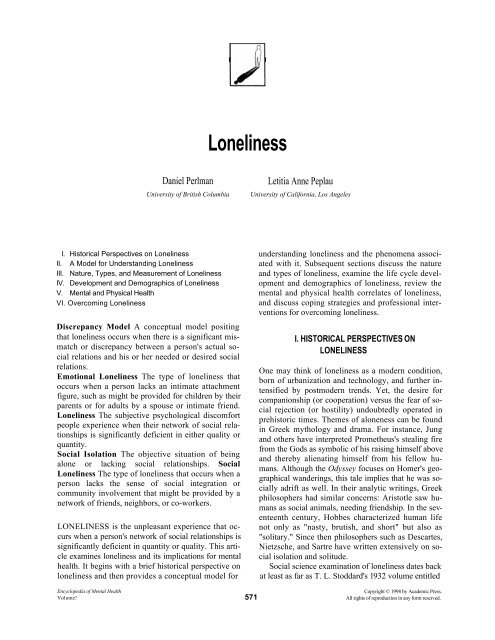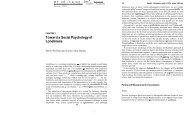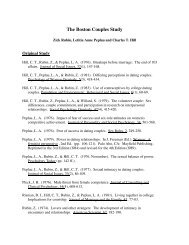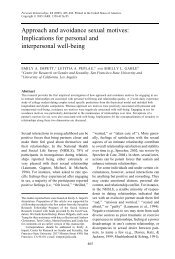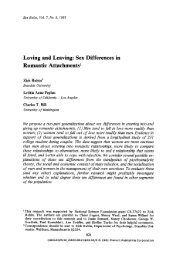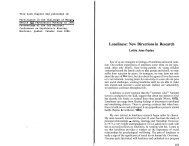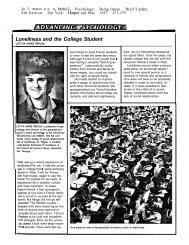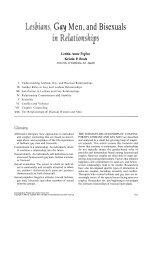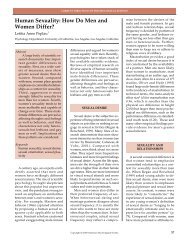Loneliness - Anne Peplau - UCLA
Loneliness - Anne Peplau - UCLA
Loneliness - Anne Peplau - UCLA
You also want an ePaper? Increase the reach of your titles
YUMPU automatically turns print PDFs into web optimized ePapers that Google loves.
572<strong>Loneliness</strong>Lonely America. In 1938, Gregory Zilboorgpublishedan article linking loneliness, which he saw as stemmingfrom early childhood experiences, with threepersonality attributes: narcissism, megalomania, andhostility. In the 15-year period after World War II,there was a small trickle of publications on loneliness,mostly by clinical psychologists who gained insightsinto loneliness from their observations of clients.Probably the best known of these authors wereFrieda Fromm-Reichmann and Harry Stack Sullivan.Fromm-Reichmann believed that real loneliness playsa role in the genesis of mental disorders including psychosisand schizophrenia. She contended that lonelinessis such a frightening experience that people in itsgrip cannot discuss it and will do almost anything toavoid it. Harry Stack Sullivan saw loneliness as an exceedinglyunpleasant experience arising when humansare unable to satisfy their need for intimacy.Available bibliographies list only a dozen or so psychologicallyoriented, English language publicationson loneliness prior to 1960. Another 64 articles andbooks appeared in the 1960s. In that decade, empiricalresearch on topics such as loneliness among olderadults became more prominent, and systematic effortsto measure individual differences in loneliness began.Moustakas published his popular book, <strong>Loneliness</strong>,on existential loneliness. A widely read sociologicalanalysis, The Lonely Crowd, by David Riesman andcolleagues, focused attention on the societal underpinningsof loneliness, a paradoxical emphasis on beinga team player and yet simultaneously distinguishingoneself individually.Approximately 170 publications on loneliness appearedin the 1970s, and nearly 650 more between1980 and June 1996. Thus, there has been a noticeableincrease in the rate of publication on loneliness.The early 1970s mark what might be called the beginningof the contemporary era for loneliness research,the era that will be covered in this article. In 1973,Robert Weiss published his influential book, <strong>Loneliness</strong>:The Experience of Emotional and Social Isolation.Since then, there have been other noteworthyedited volumes and reviews. The knowledge gainedduring this quarter century of research and theory developmentis summarized here.II. A MODEL FORUNDERSTANDING LONELINESSBefore reviewing empirical findings, it is helpful tohave a general framework for conceptualizing loneliness.Although the experience of loneliness is differentfor each individual, common elements in lonelinesscan be identified. Figure 1 presents a model for undererstandingloneliness and the phenomena associatedwith it. Central to this discrepancy model is the ideathat loneliness occurs when there is a significant mismatchbetween a person's actual social relationshipsand his or her needed or desired social relations. Aman who longs to be married but who is still singlewill feel lonely. <strong>Loneliness</strong> theorists differ in how theyconceptualize the nature of this discrepancy. Sometheorists posit basic human social needs and believethat loneliness occurs when these enduring needs arenot met. This approach is called the social needs perspectiveon loneliness. Other theorists take a morecognitive perspective, emphasizing the match betweena person's desires or expectations for relationshipsand the reality of his or her social life. This is knownas the cognitive discrepancy model of loneliness.The model in Fig. 1 also includes the more distal antecedentsof loneliness, distinguishing between predisposingfactors that make people vulnerable to lonelinessand precipitating events that trigger the onset ofloneliness. Diverse predisposing factors can increase aFigure IA model of the experience of loneliness.
<strong>Loneliness</strong>573person's risk of loneliness. Individual differences in personalityand behavior such as extreme shyness or thelack of social skills may interfere with creating or maintainingsatisfying social relationships and thereby setthe stage for loneliness. Cultural values and norms canalso affect a person's vulnerability to loneliness. Americanculture has been characterized as being highly individualistic;our values encourage personal independenceand the pursuit of individual goals even at theexpense of social ties. In contrast, other cultures inAsia, Africa, and Latin America are more collectivistic;their values encourage loyalty to family, adherence togroup norms, and the preservation of harmony in socialrelations with members of one's own group. Althoughresearch on this point is needed, it seems likelythat cultural differences in values such as individualismand collectivism affect the experience of loneliness.Within a society, social norms may also affect thetendency to feel lonely. For instance, American highschool students report more intense feelings of lonelinessif they are alone on a weekend evening (which teenculture defines as a time for socializing) than if theyare alone on a school night during the week. [SeeSHYNESS.]The person's immediate social situation can also affectloneliness. Situations vary in the opportunitiesthey provide for social contact. Some situational factorsare very basic, e.g., time, distance, and money. Thehardworking medical student may have little time forsleep, let alone making friends. The traveling salesmanwho spends most days on the road may find ithard to find a spouse. The stress of unemployment maystrain marital satisfaction and increase conflict. Situationalconstraints can also limit the pool of availablepartners. For example, because women live considerablylonger than men, older widowed women havefewer prospects for remarriage and are significantlyless likely to remarry than are older widowed men.When situational factors persist over time, they can increasethe risk of loneliness.The onset of loneliness is often initiated by a precipitatingevent, usually a change in a person's actual ordesired/needed social relationships. Examples includethe loss of an important relationship through death ordivorce or the disruption of social relations created bymoving to a new school, town, or job. Figure 1 alsoshows that how a person perceives and thinks about hisor her life situation—cognitive processes such as socialcomparison and causal attribution—affects the expe-rience of loneliness. The intensity of loneliness may beincreased if people evaluate their own situation asworse than that of their peers, or if they attribute thecauses of their loneliness to personal inadequacies. Finally,Fig. 1 calls attention to differences in the waysthat people react to being lonely.This model is not a specific theory of loneliness butrather a general framework that highlights importantelements of the loneliness experience. The componentsof this model could be analyzed from diversetheoretical perspectives. The next sections of this articlereview empirical evidence relevant to various aspectsof loneliness.III. NATURE, TYPES, AND MEASUREMENT OFLONELINESSSeveral different definitions of loneliness have beengiven. Often, these definitions reflect a particular theoreticalapproach to loneliness. For example, behavioraltheorists emphasize loneliness as a response to anabsence of social reinforcement, cognitive theoristsemphasize the perception of a discrepancy betweendesired and achieved social contacts, and psychodynamicallyoriented theorists such as Weiss and Sullivanfocus on the lack of need fulfillment. Although definitionsof loneliness vary, most assume that lonelinessresults from social deficiencies, that loneliness is a subjectivephenomenon not synonymous with objectivesocial isolation, and that it is aversive.A. The Nature of <strong>Loneliness</strong>When laypeople are asked what characteristics they associatewith a person being lonely, their answers can begrouped into three clusters. The dominant cluster includesthe thoughts and feelings directly related to theexperience of loneliness: feeling different, excluded,isolated, unloved, and inferior. Laypersons also have acluster of images about why individuals experienceloneliness: being reserved and avoiding social contacts,working too hard, and being introspective. Finally,observers also see the lonely person as having othernegative feelings: paranoia, anger, and depression.Complementing how others see lonely people, lonelyindividuals themselves report such feelings as sadness,a sense of estrangement and rejection by others, a lackof self-confidence, boredom, anger against others, anddepression.
574<strong>Loneliness</strong>B. Types of <strong>Loneliness</strong>Although they have searched for universal facets ofloneliness, researchers have also tried to identify differenttypes of loneliness. One typology uses the durationof loneliness to classify people as experiencing shortlivedor state loneliness versus long-lived or trait loneliness.Trait and state loneliness differ in several importantways other than chronicity. A first difference isthat trait loneliness has cross-situational generality;state loneliness is more situation-specific. Availableevidence also suggests that trait-lonely individuals,compared with state-lonely people, are more likely tohave deficient social skills, to attribute their lonelinessto undesirable, unchangeable aspects of their personality,and to have difficulty overcoming their socialdeficits.A second typology of loneliness was suggested byWeiss (1973), based on his analysis of what relationshipsprovide. He distinguished between emotionaland social loneliness. Emotional loneliness stems fromthe absence of emotional attachments provided by intimaterelationships. Bereavement, divorce, or emptyshellmarriages are likely antecedents of this form ofloneliness. Social loneliness stems from the absence ofan adequate social network. Moving, loss of a job, beingexcluded by peers, and not belonging to communityorganizations are likely antecedents of this form ofloneliness. The symptoms of emotional loneliness includeanxiety, a sense of utter aloneness, vigilance tothreat, and a tendency to misinterpret the hostile oraffectionate intention of others. The symptoms of socialisolation are feelings of boredom, restlessness,and marginality. The affective sequelae of emotionalloneliness are generally more intense and unpleasantthan the sequelae of social loneliness. A recent studyof Israeli university students suggests that it may bepossible to divide emotionally lonely individuals intotwo subgroups—those of the "paranoid" type withangry feelings who believe they are the targets ofothers' hostility and those who feel depressed. [SeeBEREAVEMENT.]C. Measures of <strong>Loneliness</strong>Beyond describing phenomena and delineating subtypes,social scientists are eager to operationalize constructs.In 1978, Daniel Russell and his associatespublished the University of California, Los Angeles(<strong>UCLA</strong>) <strong>Loneliness</strong> Scale. This 20-item paper-andpencilmeasure helped to spur an increase in lonelinessresearch. Since then, psychometric work has movedsteadily forward. These advances include revision ofthe <strong>UCLA</strong> scale to simplify the wording and to balancethe response pattern so that agreeing with some itemsand disagreeing with others reflects loneliness; demonstrationof the <strong>UCLA</strong> scale's discriminant validity vis-avisconstructs such as depression, social desirability,self-esteem, and anxiety; translation of the <strong>UCLA</strong> scaleinto several different languages (e.g., French, German,Greek, Japanese, Persian, Portuguese, Russian, Spanish);the development of other scales besides the <strong>UCLA</strong>measure; the development of scales for measuring traitversus state loneliness and for social versus emotionalloneliness; and the construction of scales for children.At least a dozen studies have examined the factorialstructure of the revised <strong>UCLA</strong> <strong>Loneliness</strong> Scale. Often,two or three factors are statistically identified, althoughsome investigators find just one factor and othersbelieve that underlying the multiple factors there isa single main or higher-order factor. In any case, theCronbach alpha of the <strong>UCLA</strong> <strong>Loneliness</strong> Scale is high,therefore research-oriented use of overall lonelinessscores is justified.IV. DEVELOPMENT AND DEMOGRAPHICS OFLONELINESSA. Emergence of <strong>Loneliness</strong> in ChildhoodThe exact age at which children begin experiencingloneliness is open to debate. Some have argued thatloneliness emerges in early childhood, even as early asthe first 3 months of life. Attachment research demonstratesthat within roughly the first 6 months, infantsform specific attachment bonds arid shortly thereafterdevelop separation anxieties; by 10 months, childrenresist being separated from caregivers. Others, however,have argued that loneliness does not emerge untilchildren are older. Harry Stack Sullivan believed thatchildren need to be able to form intimate chumshipsbefore the absence of such bonds can trigger loneliness.According to his analysis, this stage is not reached untilthe preadolescent period. [See ATTACHMENT.]In trying to resolve this controversy, some authoritiesclaim that infants experience separation anxietybut that this is different from loneliness per se. Weiss's
<strong>Loneliness</strong>575analysis is compatible with this view; he believes thatloneliness has more ramifications than separation anxiety.Two pieces of evidence, however, are consistentwith the position that loneliness exists well beforepreadolescence. First, symptoms of social (as opposedto emotional) loneliness (e.g., malaise, boredom, andalienation) have been observed in preschool childrenof age 3. Second, psychometric analyses of data fromchildren as young as 5 show that these children canreliably and validly complete loneliness measures. Ifthey were not already experiencing loneliness, it seemsunlikely that their answers would form meaningfulpatterns.Whenever loneliness begins, it appears to have rootsin experiences in the family. A Manitoba study of 130female undergraduates and their parents demonstratedthat daughters' loneliness scores were modestly correlatedwith both their mothers' (r = .25) and theirfathers' (r = .19) loneliness scores. This associationcould be due to either genetic or social factors. Anumber of studies have shown that lonely individualshave (or at least report that they have) cold, less nurturantparents. For instance, in one large-scale study,lonely adults were more likely than nonlonely adultsto remember their parents as having been remote, untrustworthy,and disagreeable. In another study onadolescence, greater loneliness was associated withparticipants feeling that their parents had done little toencourage them to strive for popularity and had beendissatisfied with their choice of friends.B. Prevalence of <strong>Loneliness</strong> in AdulthoodIn a representative sampling of U.S. citizens, 26% saidthat they had felt "very lonely or remote from otherpeople" in the past few weeks. Naturally, the resultsvary as a function of the exact wording of the questionposed to respondents. When asked whether they haveever been lonely in their lives, more people answer affirmatively.When asked whether they see themselves as a"lonely person," fewer respond affirmatively. Duringadulthood, loneliness also varies as a function of severaldemographic variables and life experiences.C. Nationality DifferencesSociological explanations of loneliness emphasize thatsocietal-level variables contribute to loneliness. Thus,one would expect nationality differences in loneliness.Data from the World Values Survey on how oftenpeople feel lonely support this expectation. Amongadults in 18 countries interviewed in the early 1980s,Italians and Japanese respondents reported the mostfrequent feelings of loneliness; Danish and Dutch respondentsreported the least frequent feelings of loneliness.Consistent with the analysis of American cultureby Riesman and others, respondents from theUnited States ranked high (fourth) in the extent oftheir loneliness. Within the United States, a large NationalInstitute of Mental Health (NIMH) study oftwo communities (Kansas City, Missouri, and WashingtonCounty, Maryland) found that African Americanswere more apt to report loneliness than whiteAmericans.D. Socioeconomic FactorsSeveral studies have shown that loneliness is moreprevalent among lower-income groups. For instance,in a survey of 8634 households in a large, predominantlyurban Southwestern U.S. county, members offamilies with incomes under $10,000 (in 1986) were4.6 times more likely to report loneliness than membersof families with incomes of $75,000 or more. Inthat study, education also showed an inverse relationshipto loneliness.One might expect that in most societies unemploymentis associated with loneliness. One small-scaleproject studied Oklahomans' use of the services oftheir state unemployment center., It showed that participantswho had been unemployed longer and whowere ineligible (or no longer eligible) for unemploymentbenefits were more lonely than those who hadbeen unemployed for a shorter period and who hadbenefits. More extensive testing is needed of the relationshipbetween unemployment and loneliness. [SeeSOCIOECONOMIC STATUS.]E. Gender DifferencesAn early meta-analysis found that gender differences inloneliness are measure-specific. When scores on the<strong>UCLA</strong> <strong>Loneliness</strong> Scale were analyzed, typically no differencein the scores of men and women was found. Inthe few studies (3 of 28) where differences were obtained,men tended to have higher <strong>UCLA</strong> lonelinessscores than women. This scale does not directly ask respondentsif they are lonely. In contrast, when respond-
576<strong>Loneliness</strong>ents have been directly asked if they are lonely, womengenerally reported more loneliness than men. Thus agender difference occurs when people are asked toidentify or label themselves as lonely but not whenother, less direct questions are posed.More recent findings seem consistent with these patterns.For instance, in two representative surveys of residentsof Edmonton, Alberta, men showed a nonsignificanttrend toward greater loneliness on a short formof the <strong>UCLA</strong> scale. In the development of the third versionof the <strong>UCLA</strong> scale, gender differences were foundin only one of four samples. Again, when gender differencesdid emerge in <strong>UCLA</strong> scores, men were morelonely than women. Turning to studies which explicitlyasked about feelings of "loneliness," analyses of thedata from 18 countries participating in the WorldValue Survey provide global results. In all 18 countries,women more frequently than men acknowledged feelinglonely.There are several possible explanations for sex differencesin self-labeled loneliness. One possibility thathas gained attention and support in the literature isthat it is more socially acceptable for women to expresstheir difficulties than it is for men. According to thisview, the negative consequences of admitting lonelinessare less for women than for men. This possibilityhas been tested by having university students read astandard description of a lonely person. When thelonely person was identified as a woman rather than aman, participants rated the lonely person as better adjusted,more socially acceptable, and more effective inperforming various roles. Thus, the stigma of lonelinessappears greater for men than for women. An interestingprediction for future testing is that the strongerthe traditional sex-role expectations in a society, thelarger the gender difference in reluctance to acknowledgeloneliness. [See GENDER DIFFERENCES IN MEN-TAL HEALTH.]F. Health Status and AgeA Canadian survey examined the effects of healthstatus on loneliness. The investigators obtained a representativesample of disabled adults (N = 731) from10 counties in southwestern Ontario, and then obtainedan equivalent sample of nondisabled subjects(N = 850) matched on age, sex, and area of residence.At all age levels, disabled respondents were more likelyto report loneliness than were members of the matchedsample.Figure 2 Age trends in loneliness.The media often portray old age as a time of loneliness.Consistent with this view, 65% of younger adultsaged 18 to 64 in a National Council on Aging surveysaid they thought loneliness was a "very serious problemfor most people over 65." In contrast, only 45% ofthe older adults aged 65 or older in this study concurredin this belief.To explore how loneliness actually varies over thelife cycle, data sets of respondents under and overage 65 are needed. Figure 2 is based on an unweightedaggregation of male and female respondents (N =18,682) from six surveys containing similar selflabelingquestions about loneliness. The incidence ofloneliness starts high, drops from young adulthoodthrough middle age, and then seems to increase againslightly. In the data aggregated across gender, 43% of18- to 24-year-olds reported loneliness. This droppedto 25% for respondents 45 to 64, and then rose againto 26%, 28 %, and 28% for individuals in the 65 to 74,75 to 84, and 85+ age groups, respectively.Three nuances of the association between age andloneliness are worth noting. First, the exact shape ofthe curve is influenced by gender, with sex differencesbeing greater in midlife than in young adulthood or oldage. From their 40s until their 80s, women reportedmore loneliness than men. Second, age accounts foronly a small proportion of the variance in loneliness(e.g., as little as 1 %). Third, in other studies restrictedto just older adults (aged 55+), findings on the associationbetween age and loneliness vary, some studiesshowing marked increases, others showing none at all.The magnitude of any possible increase in lonelinessamong older adults may depend on the proportions
<strong>Loneliness</strong>577of widowed and incapacitated persons in older subgroups.Finally, with slight variations, the same basicage trend also emerged when other measures of lonelinesswere used.How can age trends in loneliness be explained?One approach is to consider why loneliness might behigh or low in specific stages of the life cycle. For instance,some authors have claimed that separationfrom parents, the challenges associated with forminga personal identity, and other social transitions allcontribute to the likelihood of adolescents becominglonely. To explain the modest upturn in loneliness atthe opposite end of the life cycle, others have arguedthat a decline in the social ties of the elderly makesthem susceptible to loneliness. Research provides evidencethat older adults do indeed have smaller socialnetworks and do spend less time with others thando either adolescent or middle-aged Americans. Onthe other hand, a general decline in the experiencingof emotions (including loneliness) may diminish theloneliness that older adults would otherwise feel. Thepresence of two such countervailing forces may beuseful in understanding why the changes in later lifeare modest. [See AGING AND MENTAL HEALTH; SO-CIAL NETWORKS.]According to the cognitive discrepancy perspectivedescribed earlier, loneliness results when there is a discrepancybetween people's desired and achieved levelsof contact. Many factors may alter desired or achievedlevels of contact, but it is the gap between these parametersthat is identified as the immediate antecedentof loneliness. If the syllogism "being old = beingalone = being lonely" is faulty, this cognitive modelsuggests it may be because older adults have lowereddesired levels of social ties. Research demonstratesthat throughout the life cycle, the desired-achievedgap is a good predictor of loneliness. Whatever explanationone endorses, the idea that the retirement yearsare typically fraught with loneliness appears to bemore myth than reality.G. Correlates of <strong>Loneliness</strong>across the Life CycleThese possible explanations of age changes in lonelinessare related to another similar question: Are thepredictors of loneliness the same across the life cycle ordo they change? The answer appears to be that bothviews are correct. Several variables (e.g., personalityfactors such as self-esteem, people feeling that their re-lationships are not as good as those enjoyed by theirfriends) are associated with loneliness throughout thelife cycle. Similarly, the quality of people's relationshipsis generally a better predictor of loneliness than thenumber of social ties they have. In the interpersonaldomain, however, age-specific correlations have beenfound. For instance, as children go from preadolescenceto late adolescence to young adulthood, there is ashift in the type of relationship that is most closelylinked with loneliness. In the middle elementary years,it is the quality of children's relationships with theirmothers. In late adolescence, for example, it is thequality of college students' relationships with theirpeers. In early adulthood, romantic relationships becomecrucial. In midlife, family relations, especiallymarital relationships, predict loneliness. Among theelderly, friends and neighbors assume considerableimportance.H. Marital StatusData from respondents in more than 20 nations documentthat loneliness is less common among marriedthan nonmarried individuals. This finding is so consistentthat it has been called a sociological law. Furthermore,in one study comparing the strength of associationbetween eight common demographic factors andloneliness, marital status was the strongest predictor.When the unmarried are categorized as never marriedversus divorced or widowed, the results vary somewhatby study. The general tendency appears to be fornever-married people to be less lonely than the divorcedor widowed.In addition to these group differences, loneliness isalso part of the process of ending relationships. Whenyoung adult romantic relationships end, both partnersexperience the loss of their bond. Yet the person whois left behind is more likely to experience lonelinessthan the person who initiates the breakup. This findingcan be interpreted from a discrepancy model perspectiveas the result of a sense of control over thebreakup tempering the psychological impact of loss.The role of loneliness in the experience of divorce isillustrated by a study of 74 recently divorced men andwomen from Oklahoma. Individuals who were morelonely at the time of data collection (1 week to 3 yearspostdivorce), as compared with those who were lesslonely, blamed more of their marriages' problems ontheir former spouses. They also reported that they hadmore difficulties in their relationships with their ex-
578<strong>Loneliness</strong>partners (e.g., arguments over child rearing), drankmore, experienced greater depression, felt more cut-offfrom their friends, and were less likely to become romanticallyinvolved with a new partner. In essence,people who are lonely appear to experience more difficultiesin the process of separation. Similar findingshave been obtained for widows in the period leadingup to and after the loss of their spouses.Although marital status is important, one shouldnot be lulled into believing that it is a steadfast guaranteeagainst loneliness. Within-group analyses demonstratethat some factors increase loneliness among marriedindividuals and other factors decrease it amongthe nonmarried. Looking first at married individuals,those who are unhappy with their marriages andname another person besides their spouse as theirclosest relationship partner are vulnerable to loneliness.From the reverse vantage point, a recent Dutchstudy showed that older adults without partners canbe relatively free of feelings of loneliness when they arewell supported by friends, are more accepting of theirsingle status, and see opportunities for changing theirstatus if they wish.In summary, loneliness emerges early in life. It is especiallyprevalent in late adolescence and early adulthood.<strong>Loneliness</strong> is affected by one's demographiccharacteristics. Some categories of people includingthe poor, the disabled, and the nonmarried are atgreater risk for loneliness than others. Many psychologicalpredictors of loneliness operate at all ages, butthe strength of some interpersonal correlates of lonelinessis age-related. <strong>Loneliness</strong> is interwoven with howpeople pass through life transitions. Social transitionssuch as divorce can create loneliness. At the same time,people who are especially lonely during such transitionsmay find them more stressful and difficult than dononlonely individuals.For anyone concerned with community programsand preventive mental health, people in high-risk categoriesfor loneliness warrant special attention. Forexample, evidence that loneliness emerges in childhoodand that marriage reduces the risk of lonelinesssuggests the importance of preventive and supportiveinterventions for families. For practitioners workingwith lonely individuals, interventions may be enhancedby attention to life cycle considerations such asparenting programs to benefit young children indirectly,marital enrichment programs for individuals atmidlife, and the promotion of companionship amongthe elderly. Finally, demographic findings suggest thatloneliness is caused not only by psychological and interpersonaldynamics but also by larger social factors.V. MENTAL AND PHYSICAL HEALTHTransitory loneliness, such as the distress of beingseparated from loved ones or the difficulties of makingfriends after moving to a new town, are part of theroutine fabric of human life in modern society. In contrast,when loneliness is severe and persists for a longtime, it has more serious implications for psychologicalwell-being. Two types of research have linked lonelinessto psychological problems: self-report studies ofnonclinic samples and clinical studies of individuals intreatment.A. Self-Report StudiesA growing number of empirical studies have usedpaper-and-pencil self-report measures to assess loneliness,personality characteristics, and psychologicalproblems in samples of adolescents and adults. Severalpatterns have been found. An association betweenloneliness and depression is well established. Lonelypeople often report feeling sad and depressed, andthey score higher than the nonlonely on standardizedmeasures of depression. <strong>Loneliness</strong> is also correlatedwith low self-esteem, social inhibition or shyness, andanxiety. In men, loneliness has been linked to hostilityand to a greater potential to rape. Some studies havefound an association between loneliness and neuroticism.Lonely people are more likely than the nonlonelyto report extensive use of tobacco, alcohol, andillegal drugs. Among adolescents, loneliness has beenassociated with poor grades in school, running awayfrom home, stealing, and vandalism. [See ANXIETY;DEPRESSION; SELF-ESTEEM.]B. Clinical StudiesBeginning in the 1950s, therapists began to publish accountslinking loneliness to such psychological problemsas schizophrenia and alcohol abuse. Since then,more systematic studies of clinical samples have beenconducted. Elevated levels of loneliness have beenfound among people in counseling and psychotherapy,and also among patients in residential psychiatric fa-
<strong>Loneliness</strong>579cilities. Among Israeli soldiers, loneliness has beenassociated with mental breakdowns during or immediatelyafter battle. Individuals who have attemptedsuicide and those in treatment for alcoholism alsoshow greater loneliness. Research finds that prisonersand patients hospitalized for medical problems experienceloneliness, perhaps as a result of being separatedfrom their typical social networks. [See SCHIZO-PHRENIA.]C. Causal MechanismsAlthough much is known about the correlates ofloneliness, relatively little is known about the causalmechanisms producing these patterns of association.Consider the case of loneliness and alcoholism. Onepossibility is that loneliness leads to alcohol abuse.Some people may drink to drown their sorrows andto cope with chronic feelings of loneliness. A secondpossibility is that problem drinking leads to loneliness.Alcoholism may disrupt a person's social life,driving away friends and loved ones or leading to theloss of a job; these events may then result in loneliness.A third possibility is that some people experience manylife problems such as unemployment, poor physicalhealth, or inadequate social skills which simultaneouslylead them to feel lonely and to abuse alcohol. It islikely that all of these possible causal pathways occur.More generally, the links between loneliness and psychologicalproblems are probably reciprocal and interactive.[See ALCOHOL PROBLEMS.]D. Physical Health<strong>Loneliness</strong> is also associated with physical health problems.Compared with nonlonely peers, lonely peopleare more likely to report such symptoms as sleep disturbances,headaches, backaches, and poor appetite.In some cases, lonely people tend to worry more abouttheir health and to visit physicians more frequently. Inaddition to these self-report findings, research has alsolinked loneliness to physicians' ratings of patients.There is some evidence that physicians perceive lonelypeople as lower in general health and less likely to complywith medical regimens than nonlonely patients.There is also evidence linking loneliness to an increasedrisk of death. For example, a recent longitudinalpopulation-based study of Finnish men over the ageof 40 found that the risk of death from all causes wasgreater among men who rated their social relationshipsas inadequate and who were divorced or never married.During a 5-year period, men who rated their socialrelationships as inadequate (bottom quartile) were1.83 times more likely to die than men who rated theirsocial relationships positively (top quartile). More directevidence linking loneliness (measured by a shortform of the <strong>UCLA</strong> <strong>Loneliness</strong> Scale) and health comesfrom research on adults age 65 or older living in ruralIowa. Over a 2-year period, lonely people were significantlymore likely to move to a nursing home and to diethan were the nonlonely. This effect was found evenwhen other risk factors, such as depression, were controlled.For example, the mortality rate was 4.5 perhundred among the least lonely, but 17.5 per hundredamong the most lonely.The mechanisms linking the subjective experienceof loneliness to physical health outcomes are notwell understood. Many factors may be involved. Forinstance, lonely people may take poorer care of theirhealth or may cope with loneliness in health-compromisingways. Nonlonely people may benefit fromfriends and loved ones who offer advice and assistance.Several empirical studies suggest that physiologicalfactors may also mediate the loneliness-health association.In these studies, researchers have assessed lonelinessand immune functioning among diverse samples,including medical students, spouses of cancer patients,psychiatric patients, and men testing positive for HIV.For example, lonely medical school students have beenshown to have poorer cellular-immune control of thelatent Epstein-Barr virus and lower natural killer cellactivity than nonlonely medical students. Although resultshave not been entirely consistent, most studieshave found that lonely people show lower immunocompetencythan nonlonely people. [See PSYCHONEU-ROIMMUNOLOGY.]VI. OVERCOMING LONELINESSDuring the journey from birth to death, few people escapethe misery of loneliness. The problems leading toloneliness are varied; there is no single universal causeof loneliness. A recognition of this diversity is essentialfor understanding how people cope with lonelinessand for designing effective interventions to assist thelonely. It is useful to distinguish problems concerningthe initiation of new relationships, the maintenance of
580<strong>Loneliness</strong>satisfying relationships over time, and the dissolutionof relationships.A. Initiating RelationshipsA central problem for many lonely people is how toestablish new relationships—how to make friends,find a confidant, fall in love. For some people, the successfulinitiation of relationships is hampered by poorsocial skills, social anxiety, and shyness. Cognitivefactors may also be important: individuals with lowself-esteem, distorted perceptions of themselves, orunrealistic standards for eligible partners may havedifficulties. Yet most people manage on their own tomake friends and find partners. Parents, teachers, andother adults often try informally to help children learnsocial skills, and young people often give considerablethought to these issues as well. Clubs, sports teams,and social and religious organizations are often placesto meet new people with common interests and values.Recently, advances in computer technology andthe accessibility of the Internet have provided new opportunitiesfor people to get acquainted electronically.Several therapeutic interventions can assist peoplehaving problems initiating relationships. For example,social skills training programs have been designedfor both children and adults. Such programs use avariety of techniques (e.g., modeling, role playing,self-observation) to improve communication skillsand self-presentation. Shyness groups and assertiontraining groups have also been developed to helpindividuals overcome social inhibitions. Cognitivebehavioraltherapies are helpful to people whose selfdefeatingthought patterns impede the formation ofrelationships. [See BEHAVIOR THERAPY; COGNITIVETHERAPY.]It is also worth noting that cultural norms and valuescan affect the ease or difficulty of initiating relationships.In many parts of the world, for example, marriagesarranged by parents ensure that young adultsfind partners. Americans have the freedom of personalchoice, but also the dilemma of finding a compatiblemate. Finally, situational factors such as a person's financialresources and work obligations can also affectthe ability to initiate relationships. The firespotter wholives in a remote part of the forest has few opportunitiesto meet people. Overcoming this problem may requirea change in jobs, rather than a change in social skills.<strong>Loneliness</strong> can result not only from the absence ofrelationships, but also from having a restricted or impoverishednetwork of social relations. Social needstheorists such as Robert Weiss believe that people needa network of social relationships, including ties tofriends, a loved partner, and family. From this perspective,a happily married woman might feel lonely if shelacks close friends or has troubled relations with herco-workers. A growing body of research on loneliness,social support, and multiple roles demonstrates thatpeople benefit from having a rich and diverse socialnetwork.B. Maintaining Satisfying RelationshipsAs noted earlier, being married or having friends is nocertain guarantee of avoiding loneliness. Although wetend to think of lonely people as lacking relationships,this is not always the case. Separation from friendsand loved ones can create loneliness. Events such asgoing away to school, moving to a new town, servingin the military, or working away from home can causeloneliness. Some institutions, such as colleges, recognizethe social challenges faced by newcomers and offerorientation programs designed to ease the transitionto a new social environment.<strong>Loneliness</strong> can also arise from dissatisfaction withthe quality of existing relationships. Research has onlybegun to identify the specific features of relationshipsthat are most closely tied to loneliness. Likely candidatesinclude conflict; a lack of intimacy, reciprocity,and companionship; and low levels of rewards. Familyresearch describes empty-shell marriages that providefew benefits to the partners but persist because of childrenor other barriers to divorce. Efforts to help unhappycouples might involve couple or family counseling.Marital enrichment programs such as thoseoffered by religious groups also address this problem.For troubled relations in the workplace, conflict resolutionor mediation might be appropriate.C. Ending of RelationshipsA major cause of loneliness is the loss of a loved onethrough death, divorce, or breaking up. <strong>Loneliness</strong> thatresults when a significant social relationship ends differsfrom other types of loneliness. It may be associatedwith grief, anger, and a variety of other intense emotions.Widowhood and divorce can lead to other majorlife changes in financial resources and housing, as well
<strong>Loneliness</strong>581as to changed social networks. Effective strategies forhelping individuals who are experiencing the ending ofrelationships are tailored to the nature of the socialloss. Specific programs have been created to help thoseexperiencing divorce or widowhood. Rather than beingcast as therapy, such groups often have titles such as"Seminars for the Separated" and include lectures byexperts as well as small group discussions by people goingthrough the same type of experience. It is importantto recognize that although professional interventionsand supportive friends can help ease the loss created bydeath or divorce, they cannot eliminate this distress entirelyor quickly. It often takes considerable time for theemotional loneliness created by losing an important attachmentfigure to diminish. [See DIVORCE.]D. Self-Help: Coping with <strong>Loneliness</strong>Most lonely people do not seek professional help. Astudy of the transition to college found that less than10% of first-year students had seen a counselor ortherapist about how to overcome loneliness. Studies ofwidows find that few bereaved individuals turn to theclergy and fewer still to doctors or therapists. Relativelylittle is known about the ways in which peoplecope with loneliness, or how these coping strategiesdiffer depending on the problem that caused the loneliness.One self-report study of adults identified fourmajor coping patterns:1. Sad passivity. A state of lethargy associated withwatching television, sleeping, taking tranquilizers,overeating, drinking alcohol, or sitting and doingnothing.2. Active solitude. Finding constructive ways tospend time, such as reading, exercising, orworking.3. Spending money. Finding ways to distract oneselffrom feeling lonely.4. Social contact. Making efforts to reduce lonelinessby calling or visiting a friend.Many questions about coping with loneliness remain.How common are responses such as the fourjust described? How do reactions to loneliness changeover time? Which coping strategies are most effectivefor particular types of loneliness?This article has reviewed the current research onloneliness. Rather than being a sign of weakness, lonelinessreflects our human need for social relationships,needs that all people share. This is why the only realcure for loneliness is to establish relationships thatmeet our desires for a sense of intimacy and connectednesswith others.BIBLIOGRAPHYHojat, M., & Crandall, R. (1987). <strong>Loneliness</strong>: Theory, research,and applications. Journal of Social Behavior and Personality,2(2).Jones, W. H., & Carver, M. D. (1991). Adjustment and coping implicationsof loneliness. In C. R. Snyder & D. R. Forsyth (Eds.),Handbook of social and clinical psychology: The health perspective(pp. 395-415). New York: Pergamon Press.Marangoni, C., & Ickes, W. (1989). <strong>Loneliness</strong>: A theoretical reviewwith implications for measurement. Journal of Social andPersonal Relationships, 6, 93-128.<strong>Peplau</strong>, L. A., & Perlman, D. (Eds.). (1982). <strong>Loneliness</strong>: A sourcebookof current theory, research, and therapy. New York: WileyInterscience.Rook, K. S. (1984). Promoting social bonding: Strategies for helpingthe lonely and socially isolated. American Psychologist, 39,1389-1407.Russell, D., <strong>Peplau</strong>, L. A., 6c Cutrona, C. E. (1980). The revised<strong>UCLA</strong> <strong>Loneliness</strong> Scale: Concurrent and discriminant validityevidence. Journal of Personality and Social Psychology, 39(3),472-480.Weiss, R. S. (1973). <strong>Loneliness</strong>: The experience of emotional andsocial isolation. Cambridge, MA: MIT Press.


